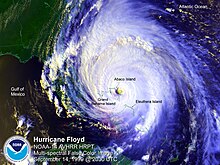 Hurricane Floyd over the Abaco Islands on September 14 | |
| Meteorological history | |
|---|---|
| Formed | September 13, 1999 |
| Dissipated | September 16, 1999 |
| Category 3 major hurricane | |
| 1-minute sustained (SSHWS/NWS) | |
| Highest winds | 120 mph (195 km/h) |
| Highest gusts | 70 mph (110 km/h) |
| Lowest pressure | 989 mbar (hPa); 29.21 inHg |
| Overall effects | |
| Damage | $50 million (1999 USD) |
| Areas affected | Florida |
Part of the 1999 Atlantic hurricane season | |
| Effects
Other wikis | |
Hurricane Floyd in 1999 threatened Florida as a major hurricane roughly three times as large as Hurricane Andrew.[nb 1] Floyd originated from a tropical wave well east of the Lesser Antilles on September 7. While approaching the Bahamas, the storm strengthened significantly between September 12 and September 13. On the latter day, Floyd peaked as a strong Category 4 hurricane on the Saffir–Simpson scale. However, upon moving closer to the Bahamas, the storm fluctuated in intensity between a Category 3 and a Category 4 hurricane. A subtropical ridge eroded by a mid- to upper-tropospheric trough over the eastern United States caused Floyd to curve northwestward over the Abaco Islands and later to northeast, avoiding a potentially catastrophic landfall in Florida. The storm made its closest approach to Florida early on September 15, passing about 110 mi (180 km) east of Cape Canaveral.
Officials and residents in the state underwent extensive preparations due to the overwhelming threat from Floyd. Tropical cyclone warnings and watches were issued, including a hurricane warning from Florida City northward – nearly the entire east coast of Florida. Almost 1.37 million Floridians were placed under a mandatory evacuation order, while approximately 2.2 million people evacuated. At least 17 counties opened shelters, which collectively housed more than 53,498 people. Thousands of travelers were left stranded after airline companies canceled flights to and from Fort Lauderdale, Jacksonville, Miami, Orlando, and West Palm Beach. Walt Disney World closed for a full day for the first time since its opening in 1971.
Ultimately, Floyd remained well offshore and thus wrought relatively minor impacts in Florida. The hurricane produced sustained winds up to 56 mph (90 km/h) and gusts up to 69 mph (111 km/h). Beach erosion affected much of the state's Atlantic coast, though the worst impacts from Floyd occurred in Brevard and Volusia counties. In both counties, erosion left some structural damage. In the latter, winds and falling trees damaged a total of 337 homes. Volusia County alone experienced about $42 million in damage. Throughout Florida, damaged totaled about $50 million (1999 USD).[nb 2]
- ^ Saffir–Simpson Hurricane Wind Scale. National Hurricane Center (Report). National Oceanic and Atmospheric Administration. May 23, 2013. Retrieved May 6, 2019.
Cite error: There are <ref group=nb> tags on this page, but the references will not show without a {{reflist|group=nb}} template (see the help page).
